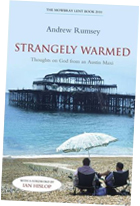| |
|
|
| Quirk of art |
 |
December 2000
Some years ago I choreographed and performed in a spoof worship dance at a well-known Christian arts festival. This was essentially a fond tribute to seventies praise pioneers The Fisher Folk, those cheesecloth-clad colossi of the chorus, from whose oeuvre we chose the evergreen, "Ask and it shall be given".
The dance which accompanied this sacred tune was, as I recall, perfectly executed: we gleefully sprang aloft in the classic "praise fountain" style; we turned away in men-loved-darkness-rather-than-light ignominy; and we wore crepe paper streamers on our wrists.
Having expected wry grins to greet our Gillette-like irony, to my alarm I found myself engaged in an early pastoral encounter with a young man for whom the dance had clearly touched hitherto unplumbed depths. "That was incredibly moving," he said.
This inability to control how others will interpret what is portrayed to them is the tricky thing about the arts, especially for Christians. One man's ichthus will be another man's poisson, so to speak – as recent debates about American Beauty served to demonstrate. To some this film brimmed with incarnate suggestion, while to others it merely loosened the bulging Bible belt another notch.
Then there are the artists – those, like Bob Dylan, who insist that their work means "what you want it to mean", or whose personal eccentricities make you uneasy about trusting their opinion anyway. Take William Blake, currently the subject of a major exhibition at Tate Britain: was he a genius, or was he – in the words of Gary Larson's psychotherapist – "just plain nuts"?
Because art is such a slippery customer, it can be common for churches and theologians alike either to ignore its capacity for expressing truth, or to employ art somewhat cynically as "incidental music" to brighten up a programme or help make a point.
One of the most encouraging developments within academic theology in the last year has been the Theology Through the Arts (TTA) foundation, based at the University of Cambridge. This project seeks to reinstall artists to a central role in exploring faith and to free the arts to express such meaning "in their own language", without always having to be translated in the tiresome manner of someone explaining a joke.
TTA approaches the ambiguity of art with welcome good sense. There is little of the arrogant romanticism that claims art is the only way to perceive reality – simply that it has a unique voice which must be heard alongside others. Art doesn't have to say everything.
Importantly also, the project doesn't use doctrine as a kind of scold's bridle to control the artist's notoriously loose tongue, but grounds its free speech in the thoroughly biblical belief in Jesus Christ as logos: the creative word in whom all creation holds together. Christ is thus the middle C; the tuning note for our performance.
What might this mean in practice? Crucially, it should affect the confidence with which artists tackle questions of meaning and truth. The quizmaster of the Enlightenment, Immanuel Kant, long ago split personal knowledge into observable fact and subjective feeling, concluding that the latter can never yield real knowledge of the world.
Ever since Kant – who clearly never underwent a Myers-Briggs personality test – consigned art (and also theology) to this "noumenal" realm, creatives have suffered from philosophical stage fright. Especially so in these postmodern times, with art increasingly switching to automatic Pilate, helplessly asking "what is truth?" when challenged to act.
George Steiner has claimed that all art is a wager on a transcendent God. A renewed appreciation of Christ as logos will not simply serve to improve the odds, but to reassure artists that such bold statements are worth making in the first place. For it suggests that at the heart of art is a Word which makes sense.
Theology Through the Arts might then be called "faith in art", as it believes both disciplines stand to gain from such refreshing conversation. If the recent TTA international festival was anything to go by, when assorted Hollywood directors, painters, poets – and, yes, dancers – gathered in Cambridge for a week of inspired artistry, this confidence would appear to be justified.
Further events and courses are being planned, details of which can be found on the website below. Streamers at the ready, I'm just waiting for their call.
Website: Theology Through the Arts |
|
|
 |
 |
 |
| Strangely Warmed by Andrew Rumsey is now available as a book. |
 |
 |
 |
 |
 |
| Stephen Tomkins' regular column of tales of religious lunacy from the far reaches of the Net |
 |
 |
 |
| Mark Howe's regular rant about Internet culture |
 |
 |
 |
| Also by Stephen Tomkins... a regular round-up of the saints of yore who were one wafer short of a full communion |
| |
|
|
|
|


